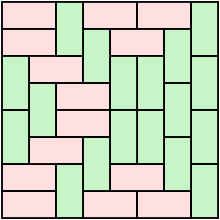Domino tiling

In
Height functions
For some classes of tilings on a regular grid in two dimensions, it is possible to define a height function associating an integer to the vertices of the grid. For instance, draw a chessboard, fix a node with height 0, then for any node there is a path from to it. On this path define the height of each node (i.e. corners of the squares) to be the height of the previous node plus one if the square on the right of the path from to is black, and minus one otherwise.
More details can be found in Kenyon & Okounkov (2005).
Thurston's height condition
Counting tilings of regions

The number of ways to cover an rectangle with dominoes, calculated independently by Temperley & Fisher (1961) and Kasteleyn (1961), is given by
When both m and n are odd, the formula correctly reduces to zero possible domino tilings.
A special case occurs when tiling the rectangle with n dominoes: the sequence reduces to the Fibonacci sequence.[1]
Another special case happens for squares with m = n = 0, 2, 4, 6, 8, 10, 12, ... is
These numbers can be found by writing them as the Pfaffian of an
The number of tilings of a region is very sensitive to boundary conditions, and can change dramatically with apparently insignificant changes in the shape of the region. This is illustrated by the number of tilings of an
-
An Aztec diamond of order 4, which has 1024 domino tilings
-
One possible tiling
Tatami
Applications in statistical physics
There is a one-to-one correspondence between a periodic domino tiling and a ground state configuration of the fully-frustrated Ising model on a two-dimensional periodic lattice.[4] To see that, we note that at the ground state, each plaquette of the spin model must contain exactly one frustrated interaction. Therefore, viewing from the dual lattice, each frustrated edge must be "covered" by a 1x2 rectangle, such that the rectangles span the entire lattice and do not overlap, or a domino tiling of the dual lattice.
See also
- Gaussian free field, the scaling limit of the height function in the generic situation (e.g., inside the inscribed disk of a large Aztec diamond)
- Mutilated chessboard problem, a puzzle concerning domino tiling of a 62-square area of a standard 8×8 chessboard (or checkerboard)
- Statistical mechanics
Notes
References
- Barahona, Francisco (1982), "On the computational complexity of Ising spin glass models", Journal of Physics A: Mathematical and General, 15 (10): 3241–3253, MR 0684591
- Erickson, Alejandro; S2CID 12738241
- Kenyon, Richard; Okounkov, Andrei (2005), "What is ... a dimer?" (PDF), Notices of the American Mathematical Society, 52 (3): 342–343
- Zbl 0444.05009
- MR 2558263
- JSTOR 2324578
Further reading
- Bodini, Olivier; Latapy, Matthieu (2003), "Generalized tilings with height functions" (PDF), Morfismos, 7 (1): 47–68, arXiv:2101.08347, archived from the original(PDF) on 2021-11-25, retrieved 2021-09-19
- Faase, F. J. (1998), "On the number of specific spanning subgraphs of the graphs ", Ars Combinatoria, 49: 129–154, MR 1633083
- Hock, J. L.; McQuistan, R. B. (1984), "A note on the occupational degeneracy for dimers on a saturated two-dimenisonal lattice space", MR 0739603
- MR 1798998
- S2CID 15679557
- Sellers, James A. (2002), "Domino tilings and products of Fibonacci and Pell numbers", Bibcode:2002JIntS...5...12S
- Stanley, Richard P. (1985), "On dimer coverings of rectangles of fixed width", MR 0798013
- Wells, David (1997), ISBN 0-14-026149-4













